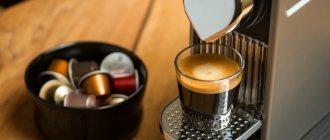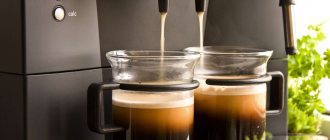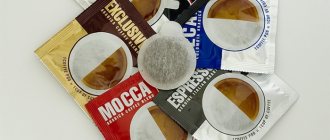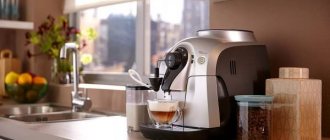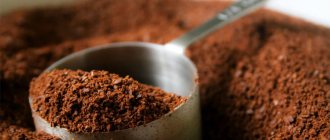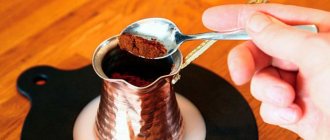What causes a coffee machine to become dirty?
There are two types of device contamination:
- A persistent plaque of calcifications is formed when water rich in calcium ions is heated. Scale accumulates mainly on the water heater, but over time it can fall off and clog other elements of the coffee maker.
- Coffee bean oil – During the process of grinding and brewing coffee, an oily coating is formed that cannot be removed with plain water. Plaque accumulates, which negatively affects the taste (a taste of rancid oil appears).
Even the most careful users who wipe up every drop and clean all filters after every use are faced with contamination problems. The instruction manual notes the need for preventive cleaning, the absence of which will immediately affect the operation of the coffee machine.
Why descale your coffee machine?
The composition of clean, tasty water includes certain minerals and trace elements: calcium, magnesium, ferrous, potassium, chloride compounds. When heated, they form a limescale deposit, which gets into the coffee as white flakes and makes it tasteless, and ultimately threatens corrosion of the internal elements. The surface of the scale is porous, and microorganisms and bacteria quickly begin to multiply in it.
The maximum amount of plaque is formed by calcium dissolved in an aqueous environment, so the process of descaling a coffee machine is often called decalcification.
You can determine when it’s time to descale your coffee machine by the following signs:
- The smell of coffee changed, it became unpleasant and musty;
- The coffee is not strong enough or under-brewed;
- The steam pressure dropped noticeably;
- The sound of the coffee machine has changed.
Some coffee machines have automatic limescale check sensors. A flashing red indicator or message on the panel informs the user that it is time to decalcify.
How often should you clean?
The frequency of cleaning work depends on several indicators:
- Machine throughput per day - if used for home purposes (3-10 servings of coffee per day), then cleaning is necessary once every 2-3 months. In catering areas, cleaning using special equipment is carried out once a week.
- The hardness of the water used - soft purified water leaves virtually no scale on the elements of the machine, while tap water contains a large amount of calcifications deposited on the walls of the heating element.
- The presence of characteristic signs of clogging of the coffee machine - the cleaning procedure is carried out as quickly as possible in order to reduce the risk of failure of the entire coffee maker system.
Expert opinion
Borodina Galina Valerievna
Some devices are equipped with sensors that remind you of the need for cleaning. If this is not the case, then you need to follow the instructions, where the manufacturer gives recommendations regarding the frequency and frequency of cleansing.
Find out which descaling procedure is suitable for your Xsmall coffee machine model.
The descaling procedure depends on the model number and serial number of the coffee machine.
The model number and serial number are located on a label on the inside of the service door.
Model number: HD8743–HD8747 and RI8743–RI8747 with serial number TW901241438213–TW901434485351. Descaling procedure for Xsmall version 1.
Model number: HD8743–HD8747 and RI8743–RI8747 with serial number less than TW901241438213 or greater than TW901434485351. Descaling procedure for Xsmall version 2.
Model number: HD8644–HD8647. Descaling procedure for Xsmall version 3.
Model number: HD8642–HD8643. Descaling procedure for Xsmall version 4.
How to recognize the need for a procedure?
There are a number of “symptoms” that indicate a clogged machine and the need to clean it:
- Unpleasant bitter taste in coffee.
- Increased time for preparing a standard portion of coffee.
- The finished drink flows out in a very thin stream.
- The outlet temperature of the finished coffee decreases.
- White persistent flakes and sediment appear in the drink.
- Extraneous sounds in the device that were previously absent.
You should not ignore this behavior of the coffee machine, as it can lead to early breakdown and the need for expensive repairs.
How to care for your coffee machine
By making it a rule to carry out regular preventive operations, you can be sure that the equipment will not let its owner down for a long time. What should you pay attention to when caring for your coffee machine?
- If the machine is equipped with a coffee grinder, for example, such as Krups EA8010PE, then you need to try to keep it dry - it is best to wipe it with a dry cloth before adding fresh beans.
- Then you need to read what kind of filter it is equipped with. If it is paper, then it needs to be changed every time it is brewed, nylon can withstand two months of daily servings of coffee, and “gold” is considered irreplaceable - its surface is coated with titanium nitride, which ensures its long-term operation.
- The automatic heating plate should be wiped clean of spilled coffee and other contaminants, then it will ensure that the prepared drink remains warm effectively and for a long time.
- The most important action should be considered timely cleaning of the container from coffee grounds and milk residues. It is their sour smell that gives the freshly prepared drink an unpleasant taste and aroma.
Useful information: 6 best coffee machine manufacturers
Common means and their features
To clean the coffee machine from scale and other contaminants, special cleaning products designed for this purpose, as well as improvised substances that have similar effectiveness, can be used.
Use of special equipment
Coffee machine manufacturers usually indicate cleaning products that can be used for a particular model, along with step-by-step instructions. The most popular of them are the following.
EcoDecalk by DeLonghi
Available in liquid form, a bottle with a dispenser. The main component is citric acid. Suitable for all types of coffee machines.
| Advantages | Flaws |
| Completely natural composition | High cost (about 2000 rubles) |
| Quite a large volume | |
| Does not cause damage to machine elements | |
| Does not harm the environment |
The cleaning product protects heating elements from premature deterioration and gently removes plaque. It washes out well with warm water and does not cause the formation of foam.
Krups
Tablets with active ingredients are suitable for coffee machines of the same brand, but according to experts, they can be used in absolutely any coffee maker.
| Advantages | Flaws |
| Removes not only scale, but also coffee oil | High price (about 1600 rubles for 10 tablets) |
| Can be used for prevention | |
| Dissolves quickly and leaves no odor in the car |
This product is ideal when using hard tap water. In 5-7 minutes, any plaque dissolves and is removed naturally, and the coffee machine works like new.
TOP House
German liquid for cleaning coffee machines combines all the advantages and has no disadvantages. Suitable for all models of coffee makers, carefully removes plaque and has a protective effect against corrosion. A convenient dispenser allows you to measure the required amount of product. The cost is about 300 rubles, which is very economical for any budget.
Available means
You can also descale your coffee machine using conventional means available in the kitchen. If you pay attention to the composition of expensive specialized products, almost all of them contain the main substance – citric acid.
The following products can also be used as cleaners:
Soda Ash
It is dissolved in warm water and poured into the machine, after which coffee without beans is prepared.
Regular soda
It copes well with greasy deposits from coffee and is suitable for manual cleaning of individual removable components.
Coarse salt
Abrasiveness cleans even the most complex contaminants, does not harm the metal and does not provoke the development of corrosion.
Such products can be used for preventive cleaning, and it is recommended to carry out planned activities with a special product.
Features of descaling coffee makers
Most modern coffee machines have a built-in indicator that will tell you about the decalcification time. If the machine does not have a similar function, the scale must be removed once a month or after 200-300 cups of brewed coffee. This is convenient if the device is equipped with a special counter that records the number of drinks prepared.
It is necessary to follow the instructions for use, know the features of the brewing mechanism and decalcify it in a timely manner.
Almost all coffee machines have removable and collapsible plastic and metal elements that can be washed and cleaned manually or using a dishwasher.
Manufacturers offer a large selection of cleaning products. In addition to their main purpose, they also have antifungal and bactericidal properties. Cleaning products are available in the form of tablets, powders or liquids. Certain models of coffee makers are configured to use chemical products of a specific brand specified by the manufacturer.
More expensive products may be more concentrated, which means they will last for more uses.
In extreme cases, when decalcification is necessary, but there is no remedy at hand, you can use simple citric acid. It works quite effectively, and will not harm or damage the mechanism or equipment parts.
Most coffee machine descaling products contain citric acid.
Mechanical cleaning: sequence of actions
Before cleaning the machine, you need to remove the used coffee and the coffee grinder compartment where the beans are located. Clean the holder where ground coffee and capsules are placed in the capsule model. Additional containers containing cream, milk, and chocolate are also removed.
When the machine is ready, start working:
- Heat the water to 35-40℃, dissolve the cleaning agent in it, according to the instructions. If you use citric acid or soda with salt, keep the proportion of 1 tablespoon per 10 liters of water.
- Place the water container in place and connect the tubes. You need to place a deep container in the drainage area where it will come out.
- Drain about 100-150 ml through the hot water button, then turn off the device for 20-30 minutes.
- Turn on the machine and select several different coffee preparation modes (3-4 will be enough). The drained water should be drained.
- Turn off the machine, disconnect the water container. Rinse it under running water. Pour in regular water that is used to make coffee. Prepare 2-3 cups of coffee without coffee. This will remove any remaining cleaning product.
- Prepare 2-3 cups of real coffee, but do not use them for food.
If the coffee after cleaning acquires an unpleasant taste or unusual smell, the cleaning procedure should be repeated, increasing the volume of water for the final stage.
Some coffee machine models have an auto-clean function. To do this, you need to pour detergent into the indicated container and press the corresponding button. All the nuances of such work are described in the instructions. But not every model can boast a set of such additional functions. This does not mean that the car does not need cleaning.
Before carrying out this kind of manipulation, it is important to read the instructions. There are nuances specific to a particular model; failure to comply with them can result in breakdowns.
Features of cleaning different types of coffee makers
Water always contains metal salts, most often calcium and magnesium carbonates. The substances are obtained during a thermal process and remain on the surface of the coffee machine elements. You will notice that the drink takes longer to obtain than before, there is an unpleasant taste or aroma, and sediment forms in the mug. According to experts in the repair of household appliances, boiler-type carob and capsule coffee makers are most prone to clogs.
On a note!
In devices with a built-in thermoblock, there are no stagnant zones for water, so scale practically does not deposit there.
How to Clean a Drip Coffee Maker
Drip coffee makers are very common due to their low price, but they will also have to be cleaned regularly. Do the following:
- take an old toothbrush and scrub the filter;
- Dilute 20 g of citric acid in 500 ml of water, pour the liquid into a water container. Add the level to the maximum mark;
- turn on the toggle switch so that the coffee maker switches to operating mode and leave the device for 5-20 minutes;
- repeat the cleaning procedure after half an hour.
After this method, there should be no traces of scale left. If the coffee machine has never been cleaned before, the source of contamination may be large. In this case, you need to remove the filter, leave it in hot water with citric acid for half an hour, then rinse it and put it back in its original place. Then start the coffee maker in normal mode, after filling it with clean water.
All the ways to break an egg and leave the yolk intact
How and with what to clean cast iron grates on a gas stove
Why salt crumbles and what to do to avoid quarreling
Why do you need baking powder and what can you replace it with if you don’t have it?
How to clean a carob coffee maker and other types
Pod, carob, and capsule coffee makers work on the same principle as drip coffee makers, but their difference lies in the design of the coffee device. Carry out cleaning according to the suggested instructions:
- turn off the device from the network so that you do not accidentally get shocked;
- remove the filled coffee cone, pour out the cake;
- rinse the receiver, then fill it with 500 ml of water with 2 tbsp. citric acid. Leave for 20 minutes;
- drain the water from the pan, turn on the device;
- set the steam mode and pass approximately 200 ml of solution through the cappuccino maker nozzle;
- change the mode to making coffee and pass the remaining solution through a clean horn.
When you have completed all the steps, fill the liquid container with water to the maximum level, and restart the program for preparing the drink. Repeat the procedure, after which you can begin normal operation of the device.
Absolutely forbidden
What cleaning products do you use?
Special Handy
In order not to provoke premature breakdown of the coffee machine, it is strictly prohibited:
- Use pure or diluted vinegar as a cleaner - acetic acid helps break down the surface protective layer of parts, which accelerates the process of metal corrosion.
- Use dishwashing, glass, and plumbing detergents - these substances, even after thoroughly washing the device, can settle on the walls and get into the coffee, causing a negative effect on the human body.
- Instead of water, pass Coca-Cola or other drinks like Soda through the machine - the release of carbon dioxide can lead to breakage of small parts, which will render the entire structure unusable.
- Pour dry powders into the machine, then add water - all products are pre-dissolved in warm water, after which they are poured into a special container, from where the liquid is taken into the coffee machine.
Expert opinion
Borodina Galina Valerievna
It is recommended to thoroughly rinse all parts of the device that came into contact with the cleaner. This ensures continued safety in preparing and drinking coffee.
Why clean your coffee machine?
If you constantly use a coffee machine, then after a while your morning coffee will begin to acquire an unpleasant taste and musty smell, or nothing but steam will flow into the cup. This is not surprising - the coffee machine simply needs cleaning, and it is advisable to do this regularly. Otherwise, this device will quickly turn into a useless non-working gadget.
Each element of the device requires a special approach - the boiler needs to be cleaned of lime deposits, the cappuccino maker needs to be cleaned of milk residues, and coffee oils need to be removed from the hydraulic system. If these rules are neglected, scale will lead to increased power consumption, and bacteria will begin to multiply in the remaining milk foam. And after a few months the car will simply break down.
Manufacturers of kitchen appliances describe in detail in the instructions all the steps for cleaning the machine, and the market offers a lot of special products that make this procedure easier.
This is interesting: How to choose the right coffee maker: 8 types of devices
How to choose the right product?
To be as confident as possible in the correctness and effectiveness of cleaning the coffee machine, you must follow 3 rules when choosing a product:
- Always use products recommended by the manufacturer, since for some models the use of uncertified products does not guarantee uninterrupted operation of the device.
- Do not use vinegar and essence, as this can lead to complete or partial destruction of metal parts, which will lead to complete unusability of the part.
- Be sure to read the instructions for the product and follow all recommendations.
As for the form of the cleaning product, there are no special differences between them. Tablets are more convenient to store, but they take longer to dissolve. The gel dissolves well and quickly in water, but it is in a bottle for 3-4 applications. The liquid dissolves easily in water, but contains a lower concentration of cleaning agent.
Methods for cleaning coffee machines
The use of one or another method depends on the brand of coffee machine, the existing difficulty and the manufacturer’s advice. A new device always comes with an annotation that contains tips and precautions for using the device. Study them to get basic information on servicing your coffee machine. In the user’s arsenal there may be a purchased product and folk methods aimed at working with machines of a certain type.
Delonghi Nespresso capsule coffee machine
Self-cleaning
Certain types of devices are supplied with an integrated self-cleaning function. Typically, these are devices with a removable teapot and cappuccino maker, which naturally become clogged, even if they are not used often. By pressing the dedicated "clean" button, you can provide preventative care. With all this, do not forget to fill the water container and place a deep glass under the nozzle, which will prevent water from splashing.
Descaling agent for coffee machine
Many manufacturers produce a line of products created for specific models. For example, a Delonghi, Philips, Nespresso and Saeco brand coffee machine is cleaned with pills of the same name, watery additives and powders. To remove scale, use powder or pill.
Manual cleaning of the device
The instructions for some devices do not indicate the use of a special tool. Typically, self-cleaning devices also do not completely remove plaque, so the manual method can also be used for them. Buy a universal product in powder form, pour it into the coffee compartment and press the button to make a drink. This simple method will free the multifunctional parts of the machine not only from scale, but also from oily deposits.
Cleaning the cappuccino maker
A coffee machine with a cappuccino maker requires careful maintenance. It must be washed immediately after use, since scale, organic particles of milk and coffee settle tightly on the walls of the device. It is best to immediately use self-cleaning and expel ordinary water through the system. You can achieve the final result only after clear water begins to fill the glass.
Pills as a ready-made solution for scale
Coffee machines from the Philips, Saeco, Nespresso and Delonghi brands are cleaned with pills produced by the manufacturers of these machines themselves. For quick cleaning, you need to place 1-2 pills in accordance with the instructions in the coffee brewing compartment. Then you press the drink making button and run the system until the pills are completely dissolved.
Citric acid instead of powder
If you don’t have a comprehensive coffee machine cleaning product on hand, you can use a universal folk method. Fill the water tank with warm water with dissolved citric acid (2-6 tablespoons). Then pour the liquid into the water compartment. Start making the drink and monitor the result. Citric acid is completely replaceable with vinegar (1/3 solution) or alcohol (half a glass per liter of water).
Coca-Cola as an enemy of scale
Pour a bottle of carbonated drink into the water compartment and run the entire volume through the coffee machine. After the procedure, you must thoroughly wash the inside with ordinary water.
What happens if cleaning is not carried out?
Some coffee machine owners accidentally or intentionally forget about preventive cleaning. This is fraught with the development of such unpleasant consequences:
- Unpleasant musty smell of coffee mixed with greasy stains.
- Cloudy dense sediment at the bottom of the cup.
- Adding loud sounds that were not there before.
- The coffee machine fails without the possibility of repair.
Prevention is the key to good and long-term operation of any equipment. If you ignore the manufacturer's advice, you will have to spend a lot of money on repairs.
Useful tips
To maximize the service life of the device, you must:
- Use only filtered bottled water, which contains minimal calcium impurities that provoke plaque formation. So cleaning can be done once every 2-3 months.
- Change filters in a timely manner so that they do not become clogged and cause clogging of small pipes.
- Clean using specialized products as required by the manufacturer.
Expert opinion
Borodina Galina Valerievna
It is recommended to clean the milk cappuccino maker several times a day. This allows you to remove remaining milk fat and prevent souring of the product that gets into the coffee.


